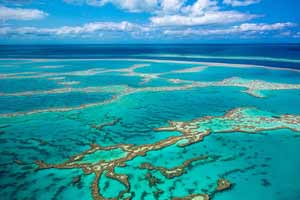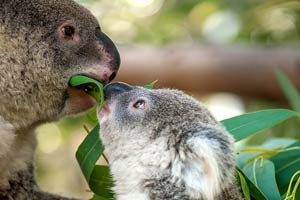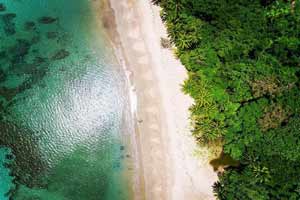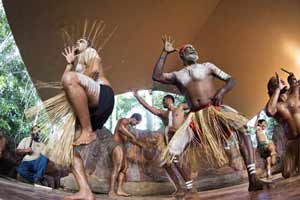
There is no sign of a doubt, Cairns is mostly famous for being the gateway to the
Great Barrier Reef – the largest coral reef system on the planet and the only visible from space, composed of 2,900 individual reefs, 900 islands and spreading over 133,000 square miles (344,400sqm). The reef is a World Heritage Site and an important part of local groups of Aboriginal descendants’ culture and spirituality. It has lost more than half of its coral cover since 1985, so protecting it and lowering the impact of tourism and fishing on it is vital. There are loads of ways to see the reef even in a day. The quickest and most scenic one would be to take a helicopter or a seaplane tour, but you can also book a boat trip, go snorkelling, paddleboarding, scuba diving, go on a glass-bottom boat, book a “seawalker” trip – any kind of sea-related activity under the sun for any budget and time-frame. Beware of the fact that there is a danger of being stung by dangerous jellyfish when you swim and snorkel in the waters of the Great Barrier Reef. Most companies that organise tours provide protective gear.
 See the village of Kuranda by skyrail and the scenic railway – constructed between 1882 and 1891, it is an engineer wonder of its time. We recommend that you combine the two ways of travel to see this lovely village, perched up above a World Heritage tropical rainforest. Stop on the way into Barron Falls Station to see this rolling cascade of waterfalls. There is loads to do in and near Kuranda. You can give a koala a cuddle at Koala Gardens, see some dazzling butterflies at Australian Butterfly Sanctuary, take a boat down Barron River, take an Army Duck tour at Rainforestation Nature Park.
See the village of Kuranda by skyrail and the scenic railway – constructed between 1882 and 1891, it is an engineer wonder of its time. We recommend that you combine the two ways of travel to see this lovely village, perched up above a World Heritage tropical rainforest. Stop on the way into Barron Falls Station to see this rolling cascade of waterfalls. There is loads to do in and near Kuranda. You can give a koala a cuddle at Koala Gardens, see some dazzling butterflies at Australian Butterfly Sanctuary, take a boat down Barron River, take an Army Duck tour at Rainforestation Nature Park.
 Daintree National Park is part of the Wet Tropics of Queensland and a World Heritage Site. It’s the oldest continuously surviving tropical forest in the world – thought to be 165 million years old. Its flora and fauna are beyond impressive. 80% of the world’s fern families are found in the area and some of the trees here are thought to be over 3,000 years old. Nearly half of Australia’s bird, mammal, butterfly, reptile and frog species can be found here. There are 10 animals that are endemic to the area, such as the Boyd’s Forest Dragon, Ulysses Butterfly, Tree Kangaroo and a Southern Cassowary. There is lots to do at this tropical paradise – camp at Cape Tribulation, where the rainforest meets the Great Barrier reef, explore the canopy at Daintree Discovery Centre, zip-line through the treetops, spot crocodiles on a Daintree River cruise, or go on a walkabout with Aboriginal guides and learn the ways of a 40,000-year-old culture.
Daintree National Park is part of the Wet Tropics of Queensland and a World Heritage Site. It’s the oldest continuously surviving tropical forest in the world – thought to be 165 million years old. Its flora and fauna are beyond impressive. 80% of the world’s fern families are found in the area and some of the trees here are thought to be over 3,000 years old. Nearly half of Australia’s bird, mammal, butterfly, reptile and frog species can be found here. There are 10 animals that are endemic to the area, such as the Boyd’s Forest Dragon, Ulysses Butterfly, Tree Kangaroo and a Southern Cassowary. There is lots to do at this tropical paradise – camp at Cape Tribulation, where the rainforest meets the Great Barrier reef, explore the canopy at Daintree Discovery Centre, zip-line through the treetops, spot crocodiles on a Daintree River cruise, or go on a walkabout with Aboriginal guides and learn the ways of a 40,000-year-old culture.
 Learn more about the world’s oldest Aboriginal culture at the Tjapukai Cultural Park. Take a refreshing, croc-free swim in the idyllic Crystal Cascades – a secret, no public transport pristine area that locals would rather keep to themselves. Palm Cove is a beautiful, relaxing, luxurious little resort with swaying palms, fringing the sandy beach.
Learn more about the world’s oldest Aboriginal culture at the Tjapukai Cultural Park. Take a refreshing, croc-free swim in the idyllic Crystal Cascades – a secret, no public transport pristine area that locals would rather keep to themselves. Palm Cove is a beautiful, relaxing, luxurious little resort with swaying palms, fringing the sandy beach.
Venture further out to Atherton Tablelands (known just as Tablelands) – a vast fertile plateau, that Kuranda is also a part of – try artisan, organic cheese from farmers that first settled here more than 100 years ago and other fresh local produce like coffee, tea, seafood and meats, served in the cafes and restaurants that the area is dotted with. Admire waterfalls, rivers, streams, gorges and a volcanic crater lake; visit Hastie Swamp, Crystal Caves, mount Mulligan Escarpment, Mareeba Wetlands and Granite Gorge Nature Park. At Undara Volcanic National Park – the traditional country of the Ewamian Aboriginal people, to see the longest lava tubes originating from a single volcano, about 160 km long.